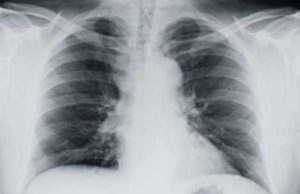
What is Pleural Effusion?
One of the most common and debilitating symptoms associated with mesothelioma cancer is pleural effusion. A pleural effusion is a build-up of fluids between the layers of tissue that surround the chest cavity and lungs. Your body naturally produces pleural fluid—albeit in small amounts—to lubricate the surfaces of the pleura—the thin layer of tissue that lines the abdomen and protects the lungs. A pleural effusion is an abnormal build-up of these fluids; it is an excessive collection of lubricant that yields painstaking symptoms such as: difficulty breathing, congestion, difficulty swallowing, a persistent of cough, shortness of breath, rapid breathing and headaches.
Diagnosing a Pleural Effusion:
Pleural effusion is typically diagnosed on the basis of a physical exam or the patient’s medical history. The condition is then confirmed by a subsequent x-ray of the chest. Pleural effusion is formally diagnosed once fluid accumulates beyond 300 ml. At this point there are typically detectable clinical signs in the patient, including decreased movement of the abdomen on the affected side, dullness to percussion over the fluids, decreased vocal resonance and diminished breath sounds. Above the area of effusion, where the lungs are compressed, there may be signs of bronchial breathing. In larger effusions, the patient may experience tracheal deviation away from the congregation of fluids.
A pleural effusion may show up on a medical image as an area of whiteness. Typically, the area between the two layers of the lung (the parietal pleura and the visceral pleura) will not be seen. A pleura effusion, thus, infiltrates the area between these two layers. Because pleura effusions possess similar densities to other bodily fluids or water, it can be observed through a radiograph. And because a pleura effusion possesses greater density than the rest of the lung, the effusion will gravitate towards the lower ends of the pleural cavity.
A pleural effusion acts according to basic fluid dynamics; it will conform to the shape of the chest cavity and lung. If the cavity contains both fluids and air, then the fluid will have a level that is horizontal instead of conforming to the lung’s shape or space.
When a pleural effusion receives formal diagnosis, the cause must be subsequently affirmed. Pleural fluid is taken out of the pleural space in a process referred to as thoracentesis. This procedure uses a needle, which is inserted through the patient’s back of the chest wall. The needle enters the pleural space through the sixth, seventh or eighth intercostal space. The fluid may then be extracted from the patient for the following tests:
• Fluid’s chemical composition will be evaluated, including its protein, glucose and albumin levels
• A culture will be taken to identify possible bacterial infections. This test may also be initiated by using a gram stain.
• The fluid will be extracted to conduct differential and a cell count
• Cytopathology will be applied to identify the presence of cancer cells or to identify infective organisms
• Other tests will be conducted depending on the clinical situation to analyze a number of things, including the patient’s lipid levels.
Types of Pleural Effusions:
Generally, there are two types of pleural effusions: Transudate and exudate pleural effusion. In a brief sense, a transudate pleural effusion is produced through pressure filtration without the presence of a capillary injury, while an exudate pleural effusion occurs from leaking between cells.
A transudative pleural effusion is defined as an effusion that is caused by systemic factors that impact the pleural equilibrium. An exudative pleural effusion, by contrast, is caused by an alteration in local factors, that in turn, influence the absorption and formation of pleural fluids in the body. A pleural effusion is regarded as exudative if at least one of the following occurs:
• The ratio of pleural fluid to serum protein is above 0.5
• The ratio of pleural fluid and serum LDH is above 0.6
• Pleural fluid is 2/3 times the normal upper limit for serum.
Causes of Pleural Effusion:
The most common cause of a transudative pleural effusion arises from cirrhosis nephrotic and left ventricular failure. These conditions ultimately lead to the increased loss of albumin.
Pleural effusion is also common in mesothelioma patients. Mesothelioma is a rare cancer that forms predominantly from prolonged exposure to asbestos fibers. The cancer affects the mesothelial cells of the serous membranes. The most common form of mesothelioma cancer, known as pleural mesothelioma, eats away at the lining of the lungs.
Malignant mesothelioma cancer destroys the membranes of a number of serous cavities in the body. These large cavities protect several vital organs in the body, including the lungs and heart.
Membranes surrounding these cavities protect several organs from abrasions and damage caused by daily movements, such as breathing. The serous membranes form from the mesothelial cells, which adhere to create the mesothelium—the surrounding tissues of the serous membranes.
Malignant Mesothelioma cancer comes in several forms:
Pericardial Mesothelioma: Originates in the lining of tissue surrounding the heart (pericardium).
Peritoneal Mesothelioma: Originates in the membrane surrounding the abdomen (peritoneum). This is a rare cancer that may also disturb the testicles, more specifically the tissues surrounding the scrotum.
Pleural Mesothelioma: The most common form of mesothelioma cancer which disrupts the lining of the lung cavity.
All mesothelioma cancers derive from cancerous tumors that are acutely located within the body. These tumors, as the disease matures, proliferate to surrounding tissue and organs.
When diagnosed, mesothelioma cancer has often metastasized to vital organs of the body. The delayed diagnosis which is seemingly routine with the cancer makes prognosis exceptionally pessimistic. The average survival time for a mesothelioma patient is only 1 to 2 years following diagnosis. Survival rates; however, fluctuate based on the form of mesothelioma cancer and the overall health of the patient.
How to Treat Pleural Effusions:
There are several palliative mesothelioma treatment options to mitigate the effects of pleural effusion. In general, pleural effusion treatment options aim to: remove fluids, prevent fluid from congregating again and treat the primary cause of the buildup.
Therapeutic thoracentesis is a common pleural effusion treatment option that is administered when the patient has a large buildup of fluids that causes intense chest pressure and breathing problems. Pleural effusion treatment options attempt to remove fluids to allow the lung to expand, ultimately making breathing easier for the patient. Treating the primary cause of pleural effusions becomes the goal of the treatment plan.
The primary means to treat pleural effusion are achieved through the insertion of small tubes in the pleural cavity. These tubes can be left in the cavity for a long period of time to fully drain the area. In other cases, the following may be administered to treat pleural effusion:
• Radiation Therapy
• Chemotherapy
• Placing medication into the abdomen to prevent the buildup of fluid after draining
• Durgery
Pleural Effusion in Mesothelioma Patients:
The earliest symptoms of mesothelioma cancer are non-specific. This inconspicuousness nature will, as stated above, lead to a delay in diagnosis. One of the most common mesothelioma symptoms is a pleural effusion, or as stated before, an accumulation of fluids between the parietal pleura (tissues that cover the chest wall and diaphragm) and the visceral pleural (area covering the lungs). Both of these tissues or membranes are protected with mesothelial cells which, in healthy bodies, produce a small amount of fluid to lubricate the area between the lungs and chest wall. Any build-up of fluids is absorbed by lymph vessels and blood to maintain a balance. When the fluid becomes overwhelming, a pleural effusion will take place.
Because a pleural effusion in a mesothelioma patient restricts the individual’s daily activities, common mesothelioma treatment will aim to remove the fluids from the cavity. In most mesothelioma treatment plans, the fluid is removed through thoracentesis—a minor surgical procedure. This operation, which is performed under local anesthesia, involves an insertion of a thin needle into the pleura space. The needle drains the fluid through a vacuum bottle. For pleural mesothelioma patients this procedure may be repeated over and over if fluid retention takes place. Fluids may also be drained through chest tubes in a procedure referred to as a tube thoracostomy.
For recurring pleural effusion, an operation known as pleuirodesis may be recommended. During this operation, a medical professional will introduce a talc substance into the space between the pleural layers. The talc irritates the pleura and closes the space between the lawyers, effectively preventing further effusion. This operation is typically performed in a hospital operating room under general anesthesia and will require at least two weeks of at home recovery.





























